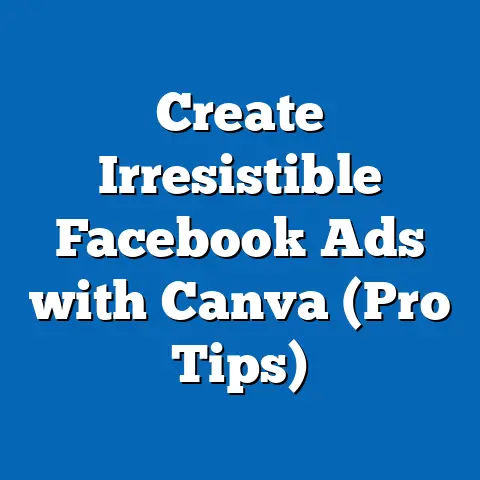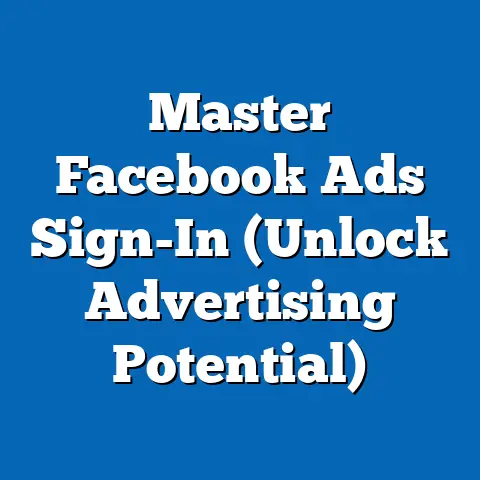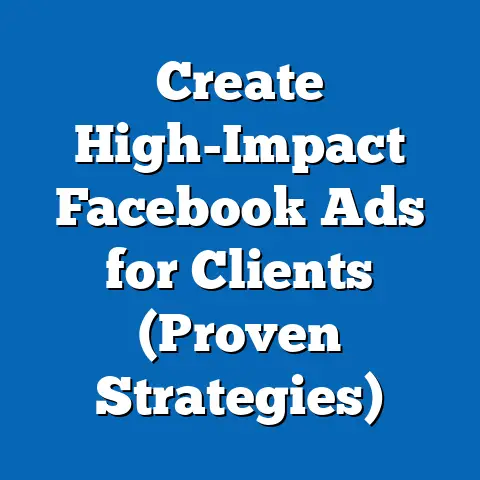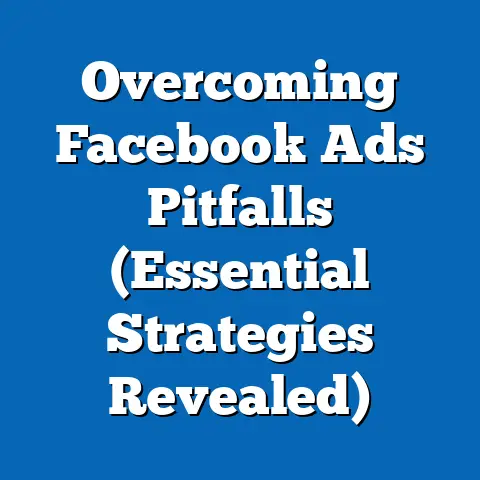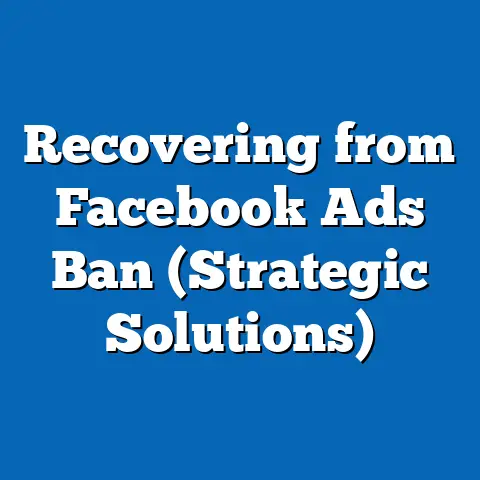Unlocking Engagement: Disabling Facebook Ad Comments (Strategic Insight)
In a digital realm where every like, share, and comment is perceived as a valuable currency, it might sound counterintuitive to even consider silencing the conversation on your Facebook ads. I mean, isn’t engagement the holy grail of digital marketing? But what if I told you that strategically disabling comments could actually amplify your brand’s voice and lead to more effective campaigns?
Facebook ads have become an indispensable tool for businesses of all sizes, allowing us to reach targeted audiences, promote products and services, and build brand awareness. We meticulously craft our ad copy, select the perfect images or videos, and fine-tune our targeting to ensure our message resonates with the right people. But what happens after the ad goes live? The comment section, often a bustling hub of opinions, questions, and feedback, can either make or break our carefully constructed campaign.
Understanding Facebook Ad Engagement
Engagement is the lifeblood of any successful Facebook ad campaign. But what does it really mean? In the context of Facebook ads, engagement encompasses all the ways users interact with your ad, including likes, shares, comments, clicks, and video views. Each of these actions signals to Facebook’s algorithm that your ad is relevant and interesting, which can lead to increased reach and lower advertising costs.
The Metrics That Matter
While all forms of engagement are valuable, some metrics carry more weight than others. Here’s a breakdown:
- Likes: A simple acknowledgment that a user appreciates your ad. While likes are easy to obtain, they provide limited insight into the user’s intent or interest.
- Shares: A more significant form of engagement, as it indicates that a user found your ad compelling enough to share with their network. Shares can significantly expand your ad’s reach and generate organic traffic.
- Comments: The most interactive form of engagement, allowing users to express their opinions, ask questions, and provide feedback. Comments can spark conversations, build community, and provide valuable insights into customer sentiment.
- Clicks: Crucial for driving traffic to your website or landing page. Clicks indicate a user’s interest in learning more about your offer.
- Video Views: Essential for video ads, indicating that users are watching and engaging with your content. View duration and completion rates are particularly important metrics.
These metrics collectively influence your ad’s performance and contribute to your Quality Score, which is a key factor in determining your ad’s ranking and cost. Ads with high engagement rates tend to perform better and cost less, as Facebook rewards relevant and engaging content.
The Power of User-Generated Content
User-generated content (UGC), particularly in the form of comments, plays a crucial role in shaping brand image and influencing consumer perception. Positive comments can act as social proof, validating your brand’s claims and building trust with potential customers. Conversely, negative comments can damage your reputation and deter potential buyers.
I remember running a campaign for a local restaurant that offered a new delivery service. The initial ads were performing well, generating a decent number of orders. However, the comment section quickly became a battleground for disgruntled customers complaining about delivery delays and cold food. Despite our best efforts to address these concerns, the negative sentiment overshadowed the positive aspects of the service, ultimately impacting the campaign’s overall success. This experience taught me the importance of closely monitoring and managing the comment section, as it can directly influence consumer perception and brand reputation.
The Psychology Behind User Engagement
Understanding the psychology behind user engagement is essential for crafting effective Facebook ads. People engage with content for various reasons, including:
- Entertainment: Users are drawn to content that is funny, entertaining, or emotionally engaging.
- Information: Users seek content that provides valuable information, solves a problem, or answers a question.
- Social Connection: Users engage with content to connect with others, share their opinions, and participate in conversations.
- Self-Expression: Users engage with content that reflects their values, beliefs, or identity.
Comments, in particular, provide an opportunity for users to express themselves, share their experiences, and connect with others who share similar interests. However, comments can also be driven by negative emotions, such as frustration, anger, or dissatisfaction. This is where the strategic decision to disable comments comes into play.
Takeaway: Understanding the nuances of Facebook ad engagement, including the key metrics, the power of user-generated content, and the psychology behind user interaction, is crucial for developing effective advertising strategies.
The Case for Disabling Comments
Now, let’s get to the heart of the matter: why would you even consider disabling comments on your Facebook ads? It seems counterintuitive, right? After all, engagement is good, and comments are a form of engagement. However, there are specific scenarios where disabling comments can be a strategic advantage, protecting your brand and improving campaign performance.
When Comments Turn Negative
The comment section can quickly become a breeding ground for negativity, misinformation, and brand reputation damage. Here are some common scenarios:
- Trolling and Spam: Malicious users often flood comment sections with irrelevant, offensive, or spammy content, detracting from the ad’s message and creating a negative experience for other users.
- Negative Reviews and Complaints: Dissatisfied customers may use the comment section to air their grievances, potentially deterring potential buyers.
- Misinformation and Fake News: False or misleading information can spread rapidly through comment sections, damaging your brand’s credibility and confusing potential customers.
- Political or Controversial Discussions: Ads that touch on sensitive topics can attract heated debates and divisive comments, distracting from the ad’s intended message and potentially alienating certain segments of your audience.
I once worked with a client in the healthcare industry who ran ads promoting a new treatment option. The comment section quickly became a battleground for anti-vaccine activists and conspiracy theorists, spreading misinformation and discouraging potential patients from seeking treatment. Despite our efforts to moderate the comments, the negative sentiment persisted, ultimately undermining the campaign’s effectiveness. In such cases, disabling comments can be a necessary step to protect your brand and ensure your message is not distorted by harmful content.
Creating a Controlled Brand Narrative
Disabling comments allows you to create a more controlled and polished brand narrative. By limiting user interaction, you can ensure that your ad’s message remains focused and consistent, free from distractions or negative influences. This can be particularly beneficial for brands that:
- Are Launching a New Product or Service: Disabling comments can help you control the initial narrative and ensure that your message is not overshadowed by premature criticism or negative feedback.
- Are Promoting a High-Value or Luxury Product: A curated and polished image is crucial for luxury brands. Disabling comments can help maintain an air of exclusivity and sophistication.
- Are Targeting a Specific Demographic: Disabling comments can help you avoid unwanted interactions or negative stereotypes that may arise from uncontrolled discussions.
Case Studies: Brands That Silenced the Conversation
Several brands have successfully disabled comments on their Facebook ads to enhance their campaigns. Here are a few examples:
- Luxury Fashion Brands: Many high-end fashion brands disable comments on their ads to maintain a sense of exclusivity and control the brand image. They rely on visually stunning imagery and carefully crafted copy to convey their message, without the risk of negative or irrelevant comments detracting from the overall experience.
- Political Campaigns: Political campaigns often disable comments on their ads to prevent the spread of misinformation and control the narrative. They focus on delivering their message through targeted ads and rely on other channels, such as their website and social media pages, to engage with voters.
- Pharmaceutical Companies: Pharmaceutical companies often disable comments on ads promoting prescription drugs to comply with regulations and avoid providing medical advice or engaging in discussions about potential side effects.
While the decision to disable comments may seem drastic, these examples demonstrate that it can be a strategic move for brands seeking to protect their image, control the narrative, and avoid negative interactions.
Takeaway: Disabling comments is not a sign of weakness or an attempt to suppress dissent. It’s a strategic decision that can be beneficial in specific scenarios, such as when dealing with negative engagement, misinformation, or the need to create a more controlled brand narrative.
Strategic Insights on Implementation
So, you’ve decided that disabling comments might be the right move for your Facebook ad campaign. Now, let’s dive into the practical aspects of implementing this strategy effectively. It’s not as simple as flipping a switch; you need to consider the technical steps, potential risks, and how to measure the impact on your overall engagement and conversions.
The Technical Steps
Disabling comments on your Facebook ads is a relatively straightforward process. Here’s how you do it:
- Go to Ads Manager: Navigate to your Facebook Ads Manager.
- Select Your Campaign: Choose the campaign you want to modify.
- Select Your Ad Set: Select the ad set containing the ad you want to edit.
- Select Your Ad: Click on the specific ad you want to modify.
- Edit the Ad: Scroll down to the “Ad creative” section.
- Disable Comments: Under “Ad creative,” you should see an option to “Allow comments.” Simply uncheck this box to disable comments on your ad.
It’s important to note that this setting applies to individual ads. If you want to disable comments on multiple ads, you’ll need to repeat these steps for each ad.
Potential Risks and Downsides
While disabling comments can be beneficial, it’s essential to be aware of the potential risks and downsides:
- Backlash from Consumers: Some users may perceive disabling comments as an attempt to suppress criticism or avoid accountability. This can lead to negative sentiment and damage your brand’s reputation.
- Reduced Engagement: Comments are a form of engagement, and disabling them may lead to a decrease in overall interaction with your ad. This can negatively impact your ad’s reach and performance.
- Missed Opportunities for Feedback: Comments can provide valuable insights into customer sentiment, product feedback, and potential areas for improvement. Disabling comments means you’ll miss out on this valuable source of information.
I recall a situation where a client, a clothing retailer, decided to disable comments on their ads promoting a new line of sustainable clothing. While the intention was to avoid potential criticism about the pricing, the move backfired. Customers perceived it as a lack of transparency and a reluctance to engage in meaningful conversations about sustainability. The campaign’s engagement plummeted, and the brand received negative feedback on other social media channels. This experience highlighted the importance of carefully considering the potential consequences before disabling comments.
Measuring the Impact
It’s crucial to measure the impact of disabling comments on your overall engagement and conversions. Here are some metrics to track:
- Reach: Monitor whether disabling comments affects your ad’s reach. A significant decrease in reach may indicate that your ad is being penalized for lack of engagement.
- Click-Through Rate (CTR): Track your CTR to see if disabling comments affects the number of users clicking on your ad. A decrease in CTR may indicate that users are less interested in your ad without the opportunity to comment.
- Conversion Rate: Monitor your conversion rate to see if disabling comments affects the number of users completing a desired action, such as making a purchase or filling out a form.
- Cost Per Acquisition (CPA): Track your CPA to see if disabling comments affects the cost of acquiring a new customer.
- Brand Sentiment: Monitor your brand sentiment on other social media channels to see if disabling comments on your ads is affecting how people perceive your brand.
By tracking these metrics, you can gain valuable insights into the effectiveness of your strategy and make informed decisions about whether to continue disabling comments or explore alternative approaches.
Takeaway: Implementing the strategy of disabling comments requires careful planning and consideration. Be aware of the technical steps, potential risks, and how to measure the impact on your overall engagement and conversions.
Alternative Engagement Strategies
Disabling comments doesn’t mean you have to abandon engagement altogether. There are plenty of alternative strategies you can use to foster interaction and build community without relying on the comment section.
Polls and Surveys
Polls and surveys are a great way to engage your audience and gather valuable feedback. Facebook offers built-in poll and survey features that you can use in your ads. These features allow you to ask questions, gather opinions, and encourage users to participate in a fun and interactive way.
I’ve found polls particularly effective for generating quick and easy engagement. For example, I ran a campaign for a coffee shop asking users to vote for their favorite coffee blend. The poll generated a ton of engagement, and the results provided valuable insights into customer preferences.
Interactive Content
Interactive content, such as quizzes, games, and contests, can be highly engaging and encourage users to spend more time interacting with your ad. These types of content can be particularly effective for driving brand awareness and generating leads.
I once created a quiz for a travel agency asking users to identify their ideal vacation destination. The quiz generated a significant amount of traffic to the agency’s website and collected valuable lead information.
Focus on Shares and Likes
Instead of focusing on comments, you can prioritize creating compelling ad content that encourages shares and likes. Here are some tips:
- Create Visually Appealing Content: Use high-quality images and videos that capture attention and resonate with your target audience.
- Tell a Story: Craft a compelling narrative that evokes emotions and connects with users on a personal level.
- Offer Value: Provide valuable information, solve a problem, or entertain your audience.
- Use a Clear Call to Action: Encourage users to like, share, or click on your ad.
Influencer Partnerships
Partnering with influencers can be a great way to drive engagement and reach a wider audience. Influencers can create content that promotes your brand and encourages their followers to interact with your ads.
I worked with a fitness brand that partnered with several fitness influencers to promote their new line of workout apparel. The influencers created videos and photos showcasing the apparel and encouraging their followers to use a specific hashtag when sharing their own workout photos. The campaign generated a ton of engagement and significantly increased brand awareness.
Takeaway: Disabling comments doesn’t mean you have to abandon engagement altogether. Explore alternative strategies, such as polls, surveys, interactive content, focusing on shares and likes, and influencer partnerships, to foster interaction and build community.
Long-Term Considerations
The decision to disable comments on your Facebook ads is not a short-term tactic; it’s a strategic decision that can have long-term implications for your brand loyalty and customer relationships. It’s essential to consider how this decision aligns with broader trends in digital marketing and consumer behavior.
Impact on Brand Loyalty
Disabling comments can potentially impact brand loyalty in several ways:
- Reduced Sense of Community: Comments can foster a sense of community among your followers. Disabling comments may make your brand appear less approachable and less interested in engaging with your audience.
- Perception of Lack of Transparency: Some users may perceive disabling comments as a lack of transparency and a reluctance to engage in open dialogue. This can erode trust and damage your brand’s reputation.
- Missed Opportunities for Building Relationships: Comments provide an opportunity to build relationships with your customers by responding to their questions, addressing their concerns, and showing that you value their feedback. Disabling comments means you’ll miss out on these valuable opportunities.
Shifting Audience Expectations
Consumer expectations regarding brand interactions are constantly evolving. In the past, brands could get away with simply broadcasting their message without engaging in meaningful conversations. However, today’s consumers expect brands to be responsive, transparent, and actively involved in the community.
Disabling comments may be perceived as a step backward in terms of meeting these expectations. It’s essential to carefully consider whether this decision aligns with your brand’s overall values and commitment to customer engagement.
Broader Trends in Digital Marketing
The digital marketing landscape is constantly evolving. Trends such as personalization, automation, and the rise of micro-influencers are shaping how brands interact with their audience.
Disabling comments may be seen as a contrarian approach to these trends. While it may be effective in specific scenarios, it’s essential to ensure that it doesn’t alienate your audience or make your brand appear out of touch with the latest digital marketing best practices.
Takeaway: The decision to disable comments on your Facebook ads is not a short-term tactic; it’s a strategic decision that can have long-term implications for your brand loyalty and customer relationships. Consider the impact on brand loyalty, shifting audience expectations, and broader trends in digital marketing.
Conclusion
Throughout this guide, I’ve explored the intriguing strategy of disabling comments on Facebook ads. We’ve examined the nuances of Facebook ad engagement, the specific scenarios where disabling comments makes sense, and the practical aspects of implementing this strategy effectively.
While it might seem counterintuitive to silence the conversation in a world that celebrates engagement, I’ve shown you that disabling comments can be a powerful tool for protecting your brand, controlling the narrative, and improving campaign performance in specific contexts.
However, it’s crucial to remember that this is not a one-size-fits-all solution. The decision to disable comments should be based on a careful assessment of your brand’s values, target audience, and the specific goals of your campaign. It’s also essential to be aware of the potential risks and downsides, and to monitor the impact on your overall engagement and conversions.
Ultimately, the evolving landscape of digital marketing and engagement requires us to constantly question our assumptions, challenge conventional wisdom, and explore new approaches. So, I encourage you to reflect on your own strategies regarding engagement and comment management on social media platforms. Are you maximizing the potential of your comment sections? Or could disabling comments be the key to unlocking a new level of success for your Facebook ad campaigns? The answer, as always, lies in understanding your audience, your brand, and the ever-changing dynamics of the digital world.

